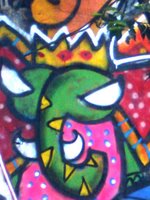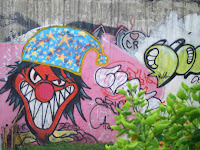
“Seni Tembok”
The Street Art of Jakarta
Jakarta is surely a little piece of heaven for trigger-happy graffitologists. You can almost see them in your mind’s eye; the city’s young blood, tattooed and bodypierced, sporting Mohawks, bandanas, gel or whatever the day’s hip head-look is, lurking behind street corners with spray cans primed. All they need is the cover of darkness and they’re at it, transforming pockets of the city into explosions of artistic energy.
And the city is more than generous; every street-artist’s dream come true. Construction sites mushroom exponentially, affording vast sweeps of metal siding begging defacement. Boundary walls built high to afford privacy provide larger-than-life expanses of prized, if temporary, canvas. Concrete pylons holding up roads choked with traffic spawn some of the best work; it’s as if busy intersections crank up the pulse of the city’s street-art.
 They are, in fact, the prime gallery spot, where an artist is guaranteed an audience of commuters all day long, well past conventional gallery closing times. The down-side, of course, is that nobody’s buying.
They are, in fact, the prime gallery spot, where an artist is guaranteed an audience of commuters all day long, well past conventional gallery closing times. The down-side, of course, is that nobody’s buying.Not five years ago, I remember how this outburst of spontaneous art was severely curtailed, cleaned off almost before it was dry. Then suddenly one year, all that changed. The powers-that-be allowed that it might remain up for the duration of the Jakarta Art Festival, which ran for a bare week or two, immediately after which Operasi Clean Up The *&^%^&* Walls kicked in.
I had actually begun to document it, particularly the specimens at the Warung Buncit/Gatot Subroto intersection, as some of them were truly fine pieces of work and I had by then spent a small fortune on film and cuci-cetak (developing and printing), immersed in tracking the evolution of this very-new-to-Jakarta phenomenon. I didn’t miss a beat, noting changes in style, content and expression, and had amassed enough material to actually consider doing a heavily illustrated post-doctoral on walls.
Alas, that was before I was seduced by digital cameras. I was using a prized Nikon SLR, in those days before jpegs and tiffs, when my photographs suddenly fell prey to a rather vicious tropical jamur, a sort of mildewy sooty type fungus, definitely not the edible variety. Silently and stealthily, it identified, attacked and destroyed all 89,533 boxes of negatives and prints. I gave them a decent burial, and in the process, lost my entire collection of carefully documented street art in one fell swoop. As you can imagine, I was desolate and borderline suicidal for months after.
Back then, a lot of the pioneering examples looked hand-painted rather than sprayed on. Many carried a message, sometimes political, sometimes socio-cultural. And all of them were done on the run. Graffiti was frowned upon by the authorities in the good old days, and if you were caught in the act, it was Real Bad News. I never did understand why; these were singularly creative, striking oases of energy and exuberance amid the numbing urban sprawl.
Those artists knew better than most that exposure is fleeting, and their masterful creations would be lost to posterity following their brief moment of glory. Because soon enough, the Graffiti Cops would come along, and…such is the price of 15 minutes of street-art fame.
Fortunately, oblivion didn’t seem to deter them, and at last they have claimed their rightful place in the sun, as you’ll find each time you’re out in the streets. The Graffiti Cops have all been fired, you don’t see them hanging around street corners with cleaning materials at the ready any more. the walls are now alive with street-art, and the flavour-of-the-month for the past year or more has been anime-comic strip style.
Over time, you begin to recognize names: ‘Artcoholic’, ‘Sta’mint Crew’, ‘Mad Feat Karma’; so fame is not always fleeting; let’s hear it for the wielders of the spray-can! I have meanwhile retired my trusty old SLR and bonded with a nifty little digital cyberwotza. Suddenly, that post-doctoral on walls is looking like a distinct possibility again.

“Seni Tembok” translates to “Wall Art” in Bahasa Indonesia.











